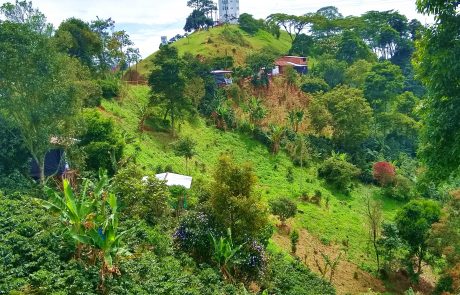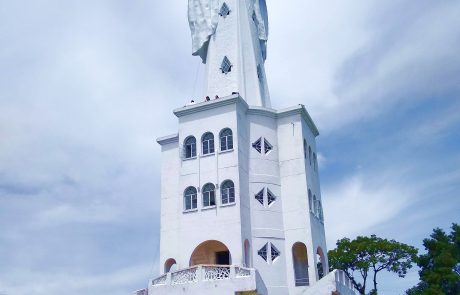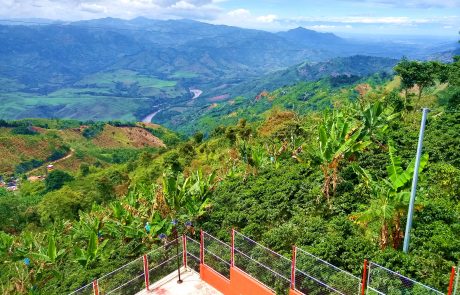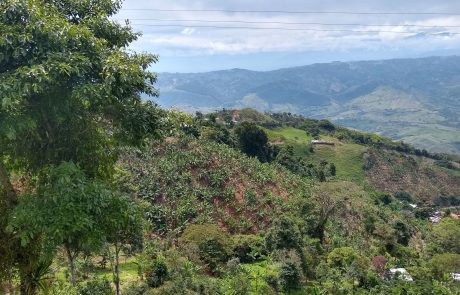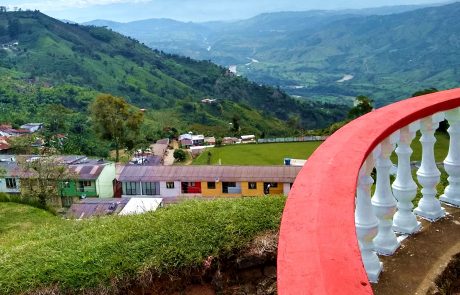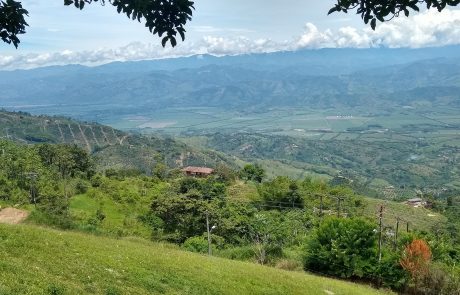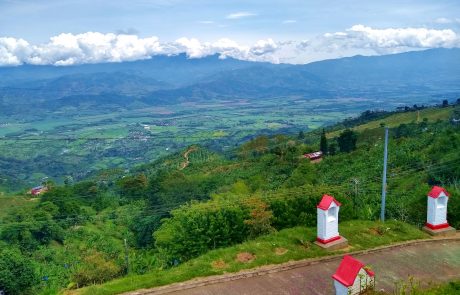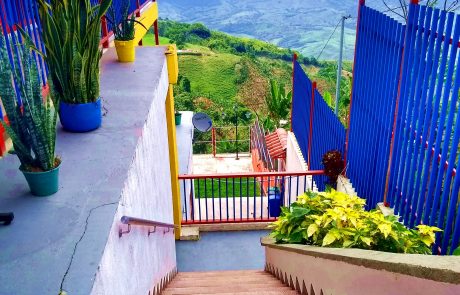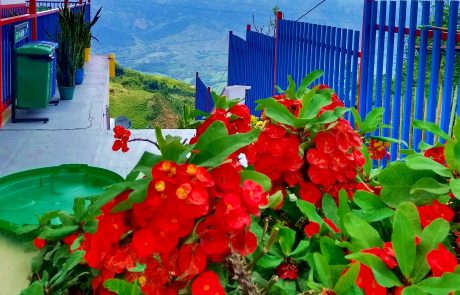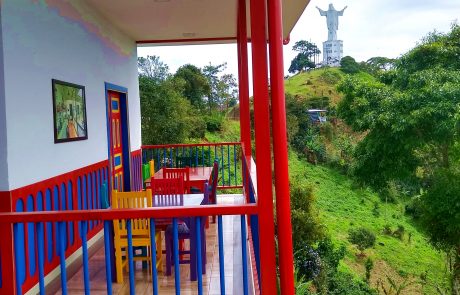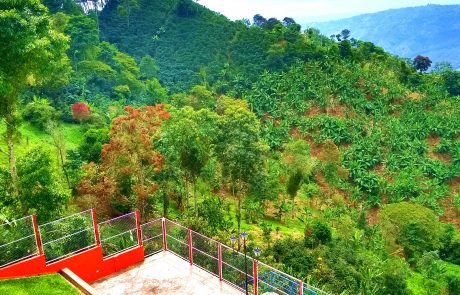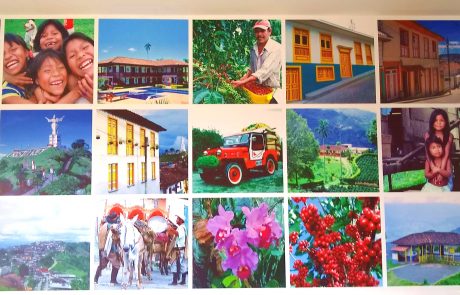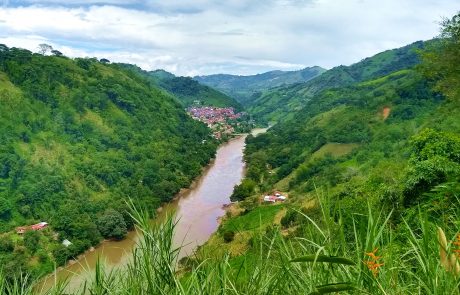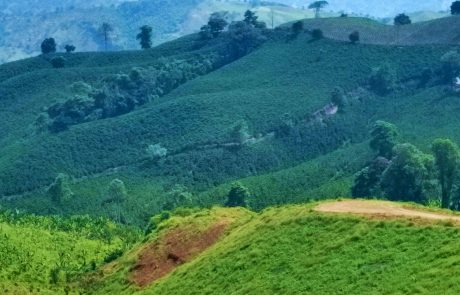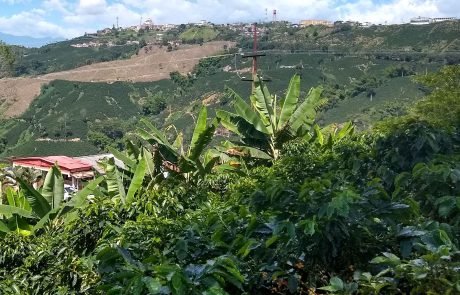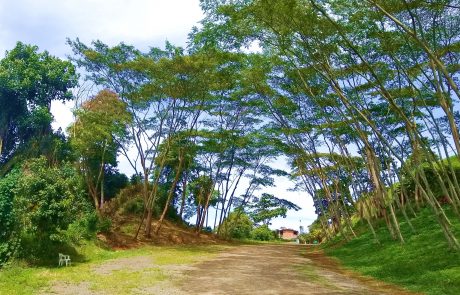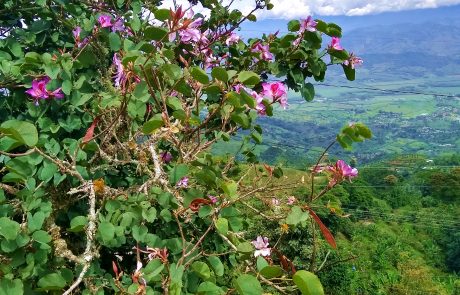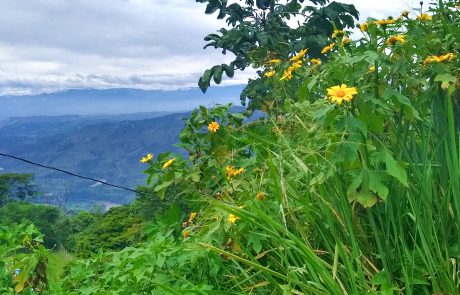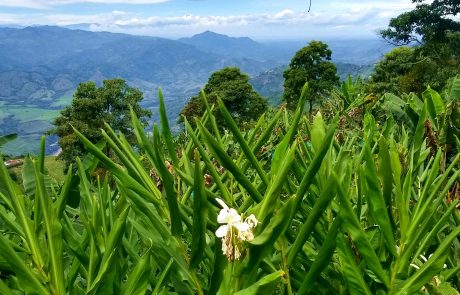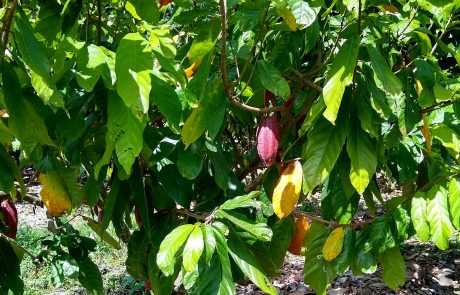August 2019
 Belalcázar has a single claim to fame: a HUGE statue of Christ the King. The English Wikipedia page on the town is a pathetic one-sentence affair enough to make any encyclopedist worth his or her salt hang his or her head in shame. Peeshaw. So we turn once again to the Spanish Wikipedia page (here) and do a bit of translation:
Belalcázar has a single claim to fame: a HUGE statue of Christ the King. The English Wikipedia page on the town is a pathetic one-sentence affair enough to make any encyclopedist worth his or her salt hang his or her head in shame. Peeshaw. So we turn once again to the Spanish Wikipedia page (here) and do a bit of translation:
Conocido como “El Balcón del Paisaje” es un destino para cualquier turista, a 40 minutos de la ciudad de Pereira y 1.5 horas de la ciudad de Manizales.
Este municipio cuenta con el monumento a “Cristo Rey”, es el único de este tipo que permite el acceso por el interior de la estatua, con lo que los turistas pueden ascender por un par de escaleras en forma de caracol hasta la cabeza de la misma y desde allí contemplar el majestuoso paisaje compuesto por 5 municipios de distintos departamentos y los valles del Río Cauca y el Río Risaralda.
[Known as “The Landscape Balcony,” it’s a destination for all types of tourists, 40 minutes from the city of Pereira and 1.5 hours from Manizales.
This municipality has the monument “Christ the King,” the only one of its kind that allows access to the interior of the statue so that tourists can enter via a pair of spiral staircases and go up to the head to contemplate the majestic landscape composed of five towns from different departments and the valleys of the Cauca and Risaralda rivers.]
Let me not tarry in providing documentary evidence:
The apparition you see is called a statue — which implies sculpture — but it’s a building, not a statue. Consequently there’s no use in stacking it up against Michelangelo or Bernini and drawing conclusions. It’s a building and serves its purpose as such quite admirably. I didn’t go up into it to get the view, being more than content with the views all round me from the vantage point I had on the carefully manicured lawn at the base. Why make trouble for yourself when there’s no need? That’s my philosophy. So I walked around the base looking at the stunning landscape and contented myself with having been present as a legitimate observer.
As you might expect, the landscape took the priority for me. The road from Pereira to Belalcázar takes you through the valley you see from the town’s heights. It’s an object lesson in the differentiation between tierra caliente (warm climate) and tierra fría (cool climate) that means more to local people than the idea of seasons. This close to the Equator seasons don’t really have the same power of conviction they have in the Bitter North where I come from. Altitude is what changes temperatures over the long-term, not month of the year. As you wend your way from Pereira to the turnoff for Belalcázar you go through the Risaralda Valley, definitely tierra caliente and known for sugar cane production, not coffee. It has a much more tropical feel to it. On the way we stopped at a pineapple stand with fruit stacked round about like cordwood. The cheerful lady at the helm peeled one and sliced it up into a metal dish, then gave each of us a small plastic bag to put over one hand so we could grab a slice and chow down. It was like candy, so sweet. Double yum.
The road to Belalcázar soon starts the climb up the mountain slopes you see towering on either side as you drive across the valley. Switchback curves are the order of the moment, with the views becoming more spectacular as you gain altitude. When you finally reach the town perched up on a ridge of the mountain range, you have the entire Risaralda Valley spread out before you to the west and the mountainous country running over toward Manizales to the east. You only have to walk across the main road to change your view from one to the other. Here are some pics of each side, the first three to the east, the last three to the west:
The view eastward is over the Cordillera Central, the middle range of the Andes chain that runs right through the country. The Risaralda Valley lying westward separates the Cordillera Central from the Cordillera Occidental, the range that runs over to the Pacific Ocean. The Risaralda Valley isn’t huge as valleys between major mountain ranges go but it’s the only game in town. Once you go down the eastern side of the mountain Belalcázar sits atop in the direction of Manizales you can kiss flat land goodbye. The terrain looks like a crumpled piece of paper with ridges at every altitude imaginable criss-crossing each other at angles that leave the mind bereft of geometry to describe them.
The views to the west remind me of terrain I’m quite familiar with from my own neck of the woods: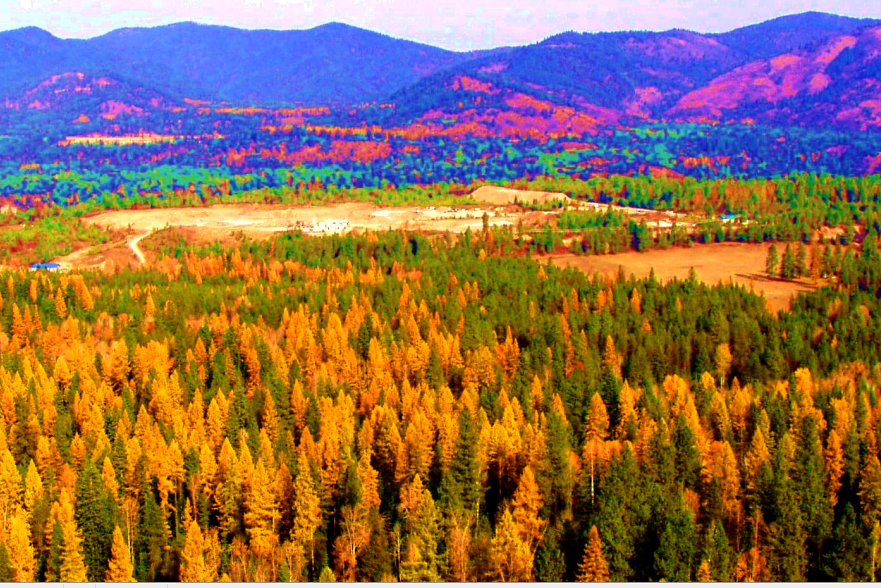
I found the similarity comforting because my brain could sort out without any effort the lay of the land and the geology underpinning it. We don’t have sugar cane growing in massive fields but the principle still applies. I sat under an avocado tree as I surveyed the Risaralda Valley — another thing you’re not likely to do in the Bitter North. I was reminded of Fluellen’s words in Shakespeare’s King Henry V on the similarity of one part of the world to another:
I think it is in Macedon where Alexander is porn. I
tell you, captain, if you look in the maps of the
‘orld, I warrant you sall find, in the comparisons
between Macedon and Monmouth, that the situations,
look you, is both alike. There is a river in
Macedon; and there is also moreover a river at
Monmouth: it is called Wye at Monmouth; but it is
out of my prains what is the name of the other
river; but ’tis all one, ’tis alike as my fingers is
to my fingers, and there is salmons in both.
Well, there aren’t salmons in both, that much isn’t out of my prains, but you get the idea. The roller coaster ride to the east will occupy us forthwith, but first a brief glance at the town on the hill.
When you come into town from the west as we did the first thing you come across is a quite handsome restaurant/hotel combination. We had breakfast there sitting on the terrace looking out over the mountains. It’s the kind of view you’d pay for through the nose in the Alps while sipping a cup of coffee the cost of which runs into double digits to the left of the decimal point. Our bill for three people to have an ample breakfast came to USD $6.00 — so take that, you Swiss highway robbers, we’ve got your number now and word is out. Just to prove my point here are some pics of the place, which I can’t recommend highly enough:
The town itself sprawls across the top of a ridge somewhat precariously. As we drove through I noticed side streets plummeting downward only to end after a single block at the edge of a precipice. Some kind of festival was going on that day so crawling through town was like wedging your way through Grand Central Station during rush hour. The streets were obviously designed for one donkey cart, not two, so two cars meeting with throngs of pedestrians on either side presented logistical dilemmas a civil engineer would probably put a big X through and scrawl over the top: START OVER. Here’s a pic from a distance:
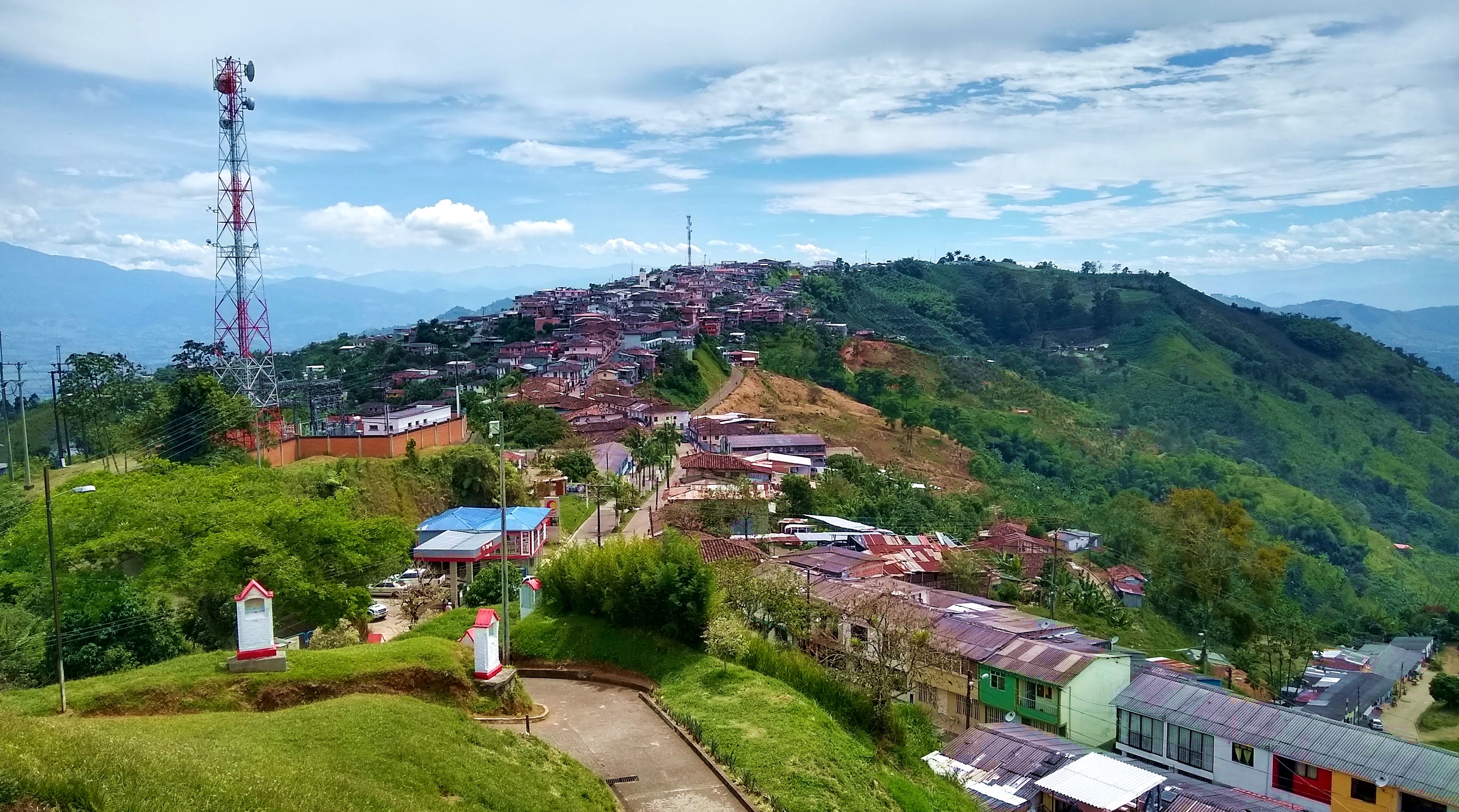
God help you if your brakes fail. It will take a week to find the wreckage somewhere down the slope in somebody’s coffee field.
We did finally manage (with some luck and a bit of swearing) to get through town and out the other side on the road headed east. As we moved along toward La Rochela, our lunch destination, my brain started to overheat as I tried to follow the contours of the landscape and take in all the details. After about 20 minutes I detected from my brain that odd smell that happens when electrical circuitry shorts out and knew immediately I needed to close my eyes and think of a flat, peaceful place to cool the brainpan off. Mind you, the terrain is gorgeous. About that point there is no contention. It’s just a bit much for a body to take in as you sit in the car watching it whiz by. Each view is complex enough texturally to deserve a few minutes of careful examination to take in all the details. No wonder I ended up on the edge of having the blue screen of death pop up on my internal monitor. Here’s a small sampling:
La Rochela looks on the map like some “little nowhere” as the French so charmingly put it, but it’s close enough to Manizales to qualify as a country getaway. Things look fairly toney and there’s a lot of vacation home building going on. We stopped for lunch at a restaurant complex with four different places offering four different specialties, a large seating area and blaring salsa music. So much for peace in the countryside. The restaurant experience left one wringing one’s hands in dismay and brought the question to one’s lips, “What in the world are you guys smoking back there in the kitchen?” The young chappie who waited on our table had the harried look of an undergraduate who’s left the term paper to the last minute and is desperately looking for enough citations to hit threshold. It was quite clear nobody had thought this business through carefully. One of my travel companions canceled his order and when I went to pay the bill the young waiter said with a pained look on his face, “Ay, Señor, que pena con ustedes.” The phrase is a Colombian colloquial expression of embarrassment meaning in this instance, “Sorry I effed up.” I told him not to worry, nobody ended up needing hospitalization, so it’s all good.
My compensation for the pena involved was the sight of a fantastic tree just outside the restaurant, an ENORMOUS old acacia covered with hangers on. Here it is in all its glory:
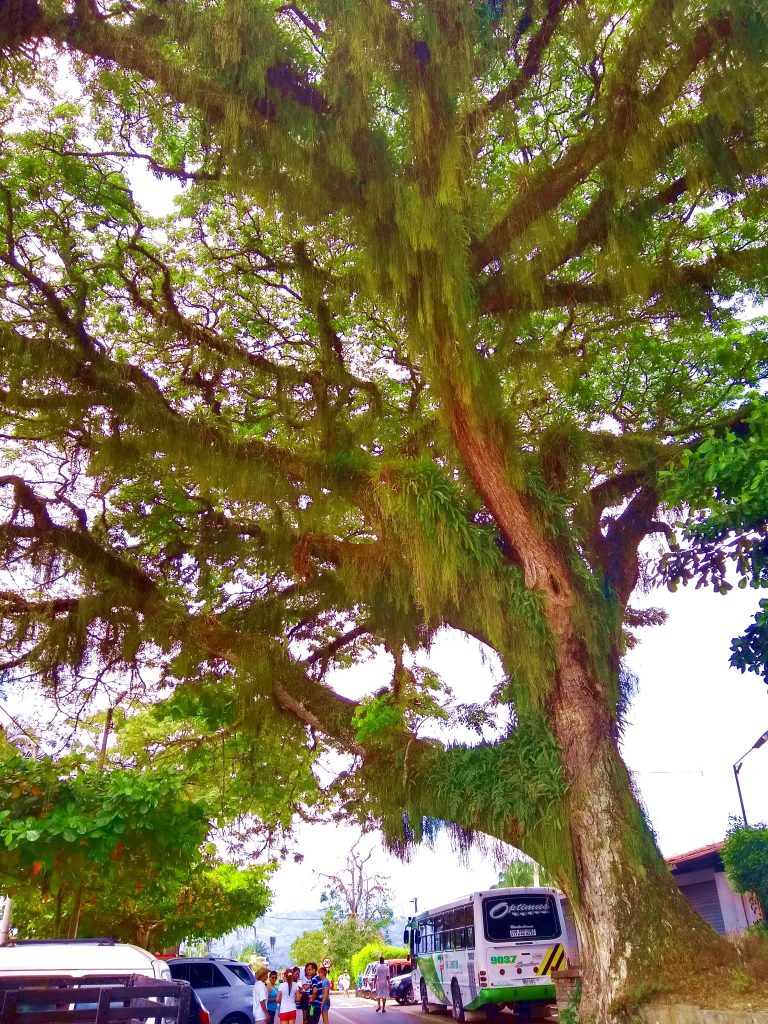
I think this is what Tolkien must have had in mind when he came up with the character of Treebeard in The Lord of the Rings. I half expected to hear our fuzzy friend start speaking Entish to us, but it held its tongue as we climbed into the car to hit the road again.
The loop continues eastward past the small and (like Belalcázar) precariously situated town of Palestina then on to Chinchiná where you get the main highway back to Pereira. I’ve mentioned Italian hill towns by way of comparison to towns in the Eje Cafetero, but I don’t remember seeing streets in any Italian hill town which, if traversed by somebody who’s had a bit too much grappa, would likely lead to a fall to the death. Again, a civil engineer would probably look at the site on a development proposal and scrawl over the top, “Are you SERIOUS?” But hey, I’m a foreigner. If people find it amusing to live with such daredevil angularity as a part of daily life, who am I to object? We didn’t ascend the steep road into Palestine, feeling that the palm branches pointed more in the direction of Chinchiná. There were quite enough switchback curves on that road to challenge my threshold of motion sickness. I came through with flying colors, I’m happy to report.
Time now for a word about our plant friends along the way. I’ll throw out the pics and then make a few comments afterward:
All the pics save for the last one were taken in the parking lot of the Christ the King site in Belalcázar. The lot was empty save for our car so I had no qualms about running around to take pictures of the botanical delights on offer. Had there been people about they probably would have thought I wasn’t firing on all cylinders since the main attraction was the thingey on top of the hill.
The stunner in the second pic is (I think, but don’t hold me at gunpoint about it) Bauhinia variegata. The Spanish name is “casco de vaca,” which seems odd since “casco” is the word for motorcycle helmet. “Cow’s Motorcycle Helmet” seems wholly improbable as a common name for any plant, let alone one as ravishing as the one in the pic. So “casco” must have some other meaning that escapes me in my ignorance. I’m happy to stick with Bauhinia, anyway, so I won’t worry my pretty little head over it.
The selfsame wild chrysanthemum in the next two pics grows on the road to Bucari in the mountains of Panay Island in the Philippines. It’s a gorgeous thing and I’ve seen it in several places here in the Coffee Triangle. Maybe Fluellen is right in saying, “but ’tis all one, ’tis alike as my fingers is to my fingers, and there is salmons in both.” There are certainly wild chrysanthemums in both, that much is undeniable.
The flowers of the ginger family (Zingiberaceae) are gorgeous, orchid-like inflorescences that make the family as important to horticulturalists as it is to the cooks of the world. I suspect the one in the pic is a wild species. There are lots of wild ginger species casting about the tropics, including the Coffee Triangle where Jack Frost never gets a foot in the door. What a delight to see such a lovely spread of the blooms on the edge of that gorgeous landscape.
The last pic comes from La Rochela where a cocoa plantation is in full swing. There’s a large stand of trees owned by a chocolate company (I have no idea which one but I can report confidently that it’s not Hersheys) on what little piece of flat land La Rochela has to offer. So it’s obviously the king of crops since it gets the best real estate. I’m such a coffeeholic that I’ve not tried Colombian hot chocolate. It’s made with agua panela which puts me off the idea. Agua panela is a concoction composed of raw cane sugar (the panela part) boiled in water (the agua part). Panela is common here. I see it in stores piled high but have never bought it. It looks like the saucer-sized excrescence of some large animal — say, an elephant. Its culinary properties and delights remain outside my zone of delectation. Things were only made worse by seeing a friend order for breakfast one morning agua panela con queso — out came a bowl of steaming brown liquid with a piece of farmer’s cheese thrown into it and some arepas on the side, which are the thick corn griddle cakes that serve as the Colombian answer to the Mexican tortilla. The farmer’s cheese is supposed to melt in the agua panela and the tough, brittle arepas are dipped in to scoop out the goodness. It looked like the dog’s dinner to me and I’d no more order it than ask for a side dish of tripe. I’m a culinary adventurer but I have my limits and they stop well short of agua panela con queso. I’ll stick to my cappuccino and croissant, thanks very much. If I find a toothsome Colombian chocolate bar I’ll waste no time in reporting it. 🙂
Once we reached Chinchiná it was clear sailing on the main highway between Manizales and Pereira. I commented to my friends that it boggles my mind to find the landscapes so different in different parts of the Coffee Triangle. The area of Caldas Department we went through is completely different from the landscapes of Quindío Department, where a plain has been dissected by watercourses into a tableland with steep ravines. The geological complexity and multifariousness of the region continues to astonish me the more I discover it. That’s a thumbs up, not a complaint. The more the geography bends my mind, the better I like it. As we have it from that modern Delphic oracle, Paris Hilton: “There is no sin worse in life than being boring …” Ain’t gonna happen with the landscapes in the Coffee Triangle, trust me.


